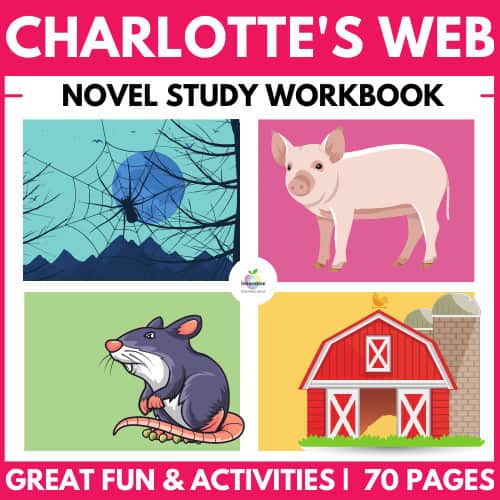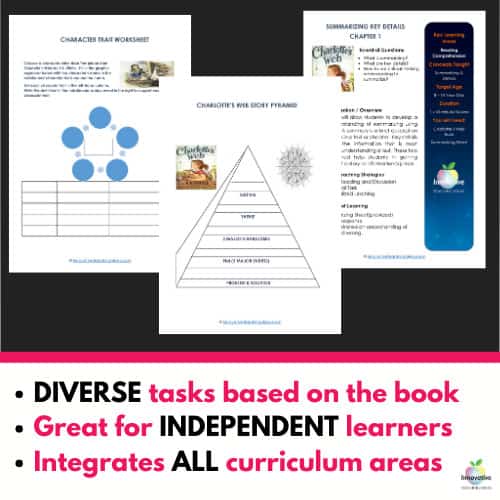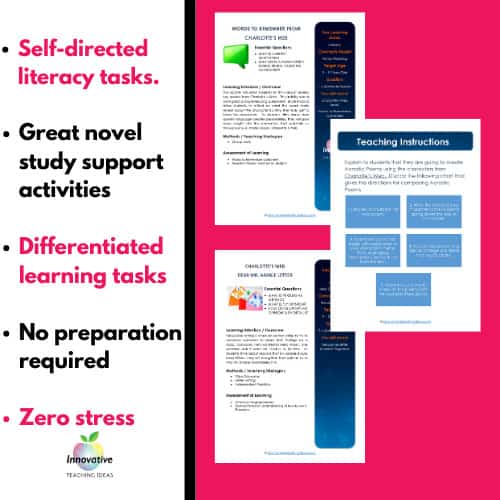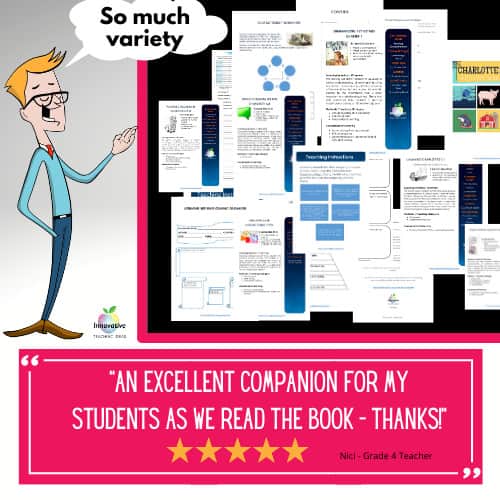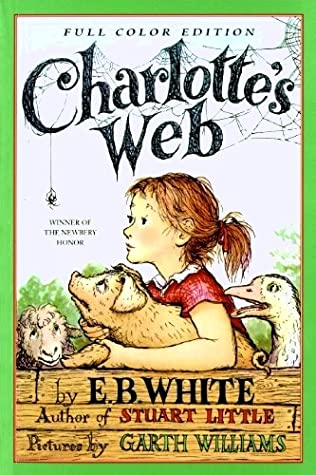
E. B White’s timeless tale of an unlikely friendship between a spider and Pig in Charlotte’s Web is the most popular children’s paperback of all time.
Published in 1952, Charlotte’s Web embodies numerous life lessons, and messages applicable to children of all ages in any era.
This charming tale unravels at a beautiful pace to give readers an authentic sense of the cycle of life on Zuckerman’s farm.
Charlotte, ( the spider ) uses all of her charm, energy and wit to prove to Wilbur, ( the pig ) and subsequently, the whole community everyone is unique and talented. Furthermore, she exemplifies to all that a little act of kindness can go a very long way.
The story has been retold in a number of formats but is best applied to students as a text. There are numerous plays and screen adaptations of this timeless tale but the 2006 cinematic version starring Dakota Fanning is an excellent screen adaptation of E.B White’s book.
We hope you enjoy our Charlotte’s Web collection. And be sure to check out our other significant literary collections, including Where the Wild things Are, Charlie and the Chocolate Factory and Narnia: The Lion the Witch and the Wardrobe.
FREE COMPLETE UNIT ON CHARLOTTE’S WEB
These Charlotte’s Web lesson plans, teaching guides and activities come with complete instructions for teachers and students.
It includes answer keys covering all aspects of one of the world’s most popular books. OVER 70 PAGES of great teaching resources for FREE.
Students will identify the 5 story elements; setting, theme, characters, plot (events), and conflict (problem) from the chapter book Charlotte’s Web by E.B. White. When students can identify story elements it helps to build an understanding of the text being read.
Summarizing the key elements of Charlotte’s Web
This activity will allow students to develop a better understanding of summarizing using key details. A summary is a brief description of the events in a text or chapter. Key details pertain to the information that is most important in understanding a text. These two skills combined help students in gaining insight into a story or informational piece.
Click here to download the entire lesson plan worksheets, and answer key for free.
Teach students about character traits in Charlotte’s Web
In a follow up to our last lesson about summarizing key elements from Charlotte’s web today we will be focussing on Character traits from Charlotte’s Web.
This activity will allow students to develop an understanding of character traits that include personality traits as well as physical traits. Students will use characters’ actions and/or dialogue from the text to determine character traits.
Teaching students the vocabulary of Charlotte’s Web
This activity will allow students to explore vocabulary from Charlotte’s Web and practice using a dictionary to better understand words. Once students comprehend vocabulary, they can better make connections in text and, in conclusion, better understand the story.
Teaching poetry with Charlotte’s Web

Acrostic Poems are typically easy to write and can be used in any subject with any topics. Acrostic Poems allow creativity and spell out messages for readers to visually and mentally understand. This activity will promote student creative writing as well as character descriptions from the classic children’s novel Charlotte’s Web.
Click here to download the entire lesson plan.
Developing a deeper understanding of the characters of Charlotte’s Web
This activity will allow students to develop an understanding of characters in a more comprehensive manner. When students know which characters are important to the plot and climax in a story it helps to build the readers understanding of the text. This also allows students to make real-world connections and relate to the characters in a book much like they would in a movie. Mental images can be used by the reader to comprehend character(S) thoughts, moods, intentions, and feelings.
Click here to download the entire lesson
Teaching synonyms through Charlotte’s Web
Synonyms are words or phrases with the same or similar meanings. This activity will practice identifying and locating synonyms for vocabulary words used in Charlotte’s Web. Synonyms enhance writing and allow students to vary vocabulary usage without changing the contextual meaning of the story.
Click here to download the entire lesson plan
Teach students about antonyms through Charlotte’s Web
Antonyms are words or phrases with opposite meanings. This activity will practice identifying and locating antonyms for vocabulary words used in Charlotte’s Web. Antonyms are a vocabulary skill that is important due to changing sentence meaning.
Click here to download the entire lesson plan and resources
Constructing a literature response to ‘Charlotte’s Web’
Independent reading is a necessary real-world skill. In addition, classrooms expect independent readers by the time students reach elementary grades 4th and 5th. This activity will allow students to develop an understanding of how to respond to literature and how these responses build comprehension skills. The more students are focused on their reading the more independent they become. Literature responses improve student focus and can be used as formative assessments for standards related to literature and informational text.
Click here to download the lesson plan and resources
Teaching sequencing through ‘Charlotte’s Web’
This activity will allow students to think about the order of events in Charlotte’s Web. As students recall, specific actions that were performed by the characters, they are practising the vital reading skill known as sequencing. Undoubtedly, knowing the order in which events happen is a key skill in reading comprehension.
Click here to download the entire lesson plan and resources
Working with quotes from Charlotte’s Web
This activity will allow students to think about several key quotes from Charlotte’s Web. This activity would work great as a pre-reading assessment since it would allow students to reflect on what the words really reveal about the character BEFORE they truly get to know the characters. As students think about how spoken language creates personalities, they will gain more insight into the characters that entertain us throughout E. B. White’s book, Charlotte’s Web.
Click here to download the entire lesson plan and resources
Teaching persuasive writing through Charlotte’s Web
Persuasive writing is when an author writes to try to convince someone to share their feelings on a topic. Obviously, Fern wanted to keep Wilbur. She certainly didn’t want Mr. Arable to kill him. As students think about the reasons that Mr Arable should keep Wilbur, they will strengthen their opinion as to why Mr. Arable should keep him.
Click here to download the lesson plan and all resources
Teaching math’s through Charlotte’s Web
This activity allows students to think about how science is represented in E. B. White’s novel, Charlotte’s Web. Students will explore the identities of different species that present in this treasured children’s novel. They will use their knowledge of the food chain to determine where different animals fit into the food chain. This requires critical thinking and allows the students to look at the novel from a unique scientific perspective.
Click here to download the entire lesson plan and resources
Teaching point of view through Charlotte’s Web
This activity will allow students to demonstrate understanding from a character’s point of view (1st person). There are numerous ways for readers to respond to literature. This promotes insight into text and allows students to reveal their thinking, feelings, and reactions to the literature they have read. This activity will also review and practice how to write a friendly letter correctly.
Click here to download the entire lesson plan and resources
Great Charlotte’s Web wordsearch and crossword
As part of our large collection of Charlotte’s web resources and teaching ideas feel free to download this great word search. It contains a solution as well. Enjoy.
Click here to download the word search, crossword and solutions.
Official Charlotte’s Web Teaching Guide – 12 pages of inspiration and ideas
Official Teaching Guide for the 2006 film
Charlotte is Wise, Patient, and Caring: Adjectives and Character Traits
Students explore adjectives, then use them to describe themselves and others. This lesson is designed for Charlotte’s Web but can be adapted to other works.
Charlotte’s Web
Summary and analysis, with links to online quizzes and related sites.
Charlotte’s Web
This unit plan includes 2 activities, reproducible, and links to discussion questions and vocabulary words.
Charlotte’s Web
A variety of activities to support the novel.
Charlotte’s Web
Scroll down on this page to find 9 activities to support the book.
Charlotte’s Web
Links to several activities, including chapter summaries, mystery quotes, and list poems. Designed for second graders.
Charlotte’s Web
Summary and 2 activities.
Charlotte’s Web
Printable word search. Access requires Adobe Reader.

Charlotte’s Web: Become a True Friend
The 11 activities presented here use literacy skills to explore true friendship, appreciate diversity and embrace change, farm animals, and community service. The 36-page discussion guide requires Adobe Reader or a compatible application for access. It is designed for students ages 8-12 and supports the 2006 movie version.
An E. B. White Word Search
An online word search using the names of characters from E. B. White.
E. B. White on Why He Wrote Charlotte’s Web White’s response to prepublication concern about a children’s book that had a spider as a main character. Includes a few of White’s drawings.
On the Farm with Wilbur and Charlotte
During this unit, students will explore many aspects of the book Charlotte’s Web. Students will work as a group to develop a presentation, design a web page, and prepare a newsletter. They will also complete a WebQuest about Charlotte’s Web and study farm animals.
Pick the Perfect Word
In these 5 interactive activities, students work with synonyms, prefixes, nouns, adjectives, and verbs.
The Power of Words in Charlotte’s Web
Students analyze passages from the book and identify how the adjectives Charlotte used to characterize Wilbur transformed his life. Then, students design “word webs” to use in a game where students must guess adjectives used to describe themselves, based on synonym clues.
– See more at: http://www.webenglishteacher.com/charlottes-web-lesson-plans.html#sthash.rl93tZJk.dpuf
Resources from Ashton Scholastic
Lesson Plans
Lesson 1: Comic Strip Creations
Lesson 2: What’s the Word?
Reproducibles
Charlotte’s Web Discussion Questions
Discussion questions for teaching Charlotte’s Web by E. B. White.
Charlotte’s Web Vocabulary Boosters
Use these 20 vocabulary words from Charlotte’s Web for your weekly list, daily word study, or spelling exercises.
Activities and Worksheets
Bar Graph for Favorite Character – Survey Sheet
Fern Character Map & Paragraph
Friendship – Personal Application
Map the Farm – draw a map
Charlotte’s Web Story Problems
Enchanted Learning Farm Activities
Further Lesson Plans
Teacher Vision – lots of lessons and ideas


